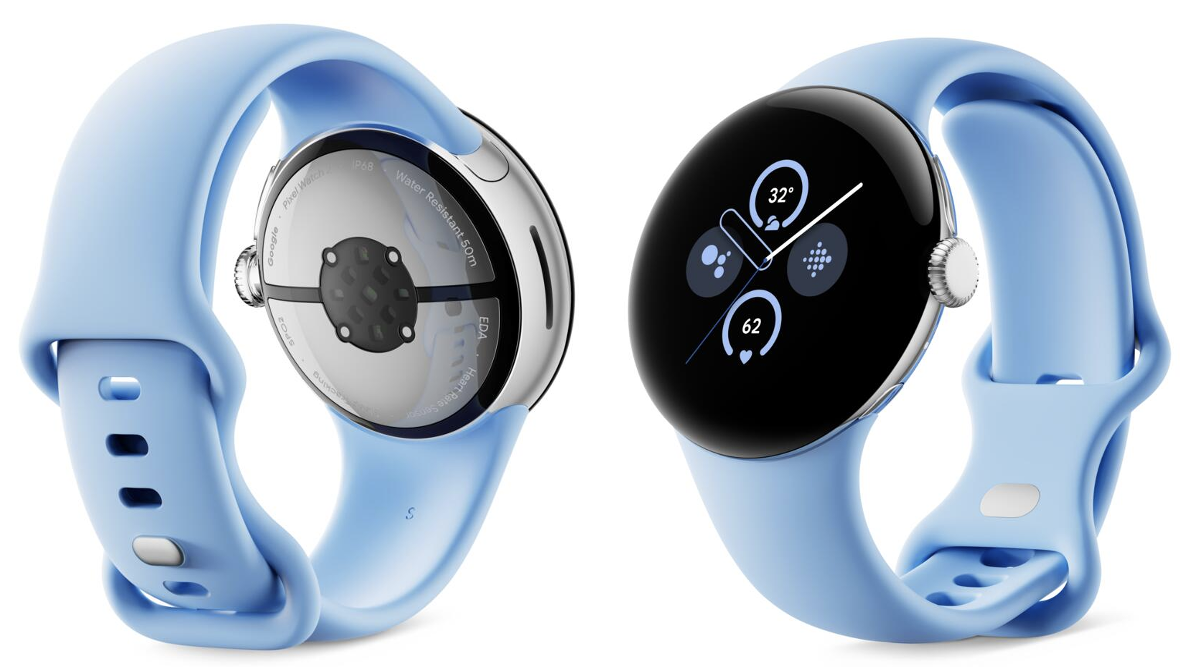
What does electrodermal sensing reveal? Insights from the Pixel Watch & Fitbit Sense 2
October 24, 2024
Daniel McDuff and Seamus Thomson, Research Scientists, Consumer Health Research Team
We present research on electrodermal activity for measuring stress levels in real-world settings, revealing interesting patterns in physiological arousal related to daily routines, holidays, major sporting events, and mental health.
Have you ever noticed how your palms might get a bit clammy when you’re nervous or excited? Especially that last minute of the Super Bowl or when the doorbell rings on Thanksgiving? When presented with many stimuli (both good and bad) the sympathetic nervous system triggers a physiological response that prepares the body to respond. This response includes increased sweat gland activity, which is where electrodermal activity (EDA) comes in. EDA sensors measure subtle changes in the electrical conductance of skin caused by that sweat, even before one consciously notices it. By detecting these changes, EDA can become a valuable tool for understanding how and when someone reacts to stress or excitement, offering insights into the complex relationship between our minds and bodies.
While EDA has been a cornerstone of psychological research since the 1960s for assessing nervous system arousal and stress, its real-world application in large-scale studies has been limited because of a paucity of remote measurement capabilities on consumer devices. However, in September 2022, Fitbit debuted the world’s first consumer on-wrist continuous electrodermal activity (cEDA) sensor for all-day tracking, which is currently available on Google Pixel Watch 2 and 3 and Fitbit Sense 2.
To advance our understanding of EDA and demonstrate the power of continuous measurement on a large scale, today we discuss two papers on quantifying physiological changes across a range of scenarios. We start with “What Does Large-scale Electrodermal Sensing Reveal?”, in which we investigate what large-scale EDA sensing in-situ reveals about diurnal and circadian variations in sympathetic arousal. Then in “Evidence of Differences in Diurnal Electrodermal, Temperature, and Heart Rate Patterns by Mental Health Status in Free-Living Data”, we report on how differences in these patterns, consistent with prior research using other biosignals, could be markers of differences in mental health and wellbeing.
EDA in everyday life
We all know that certain events can cause stress, for both good and bad reasons! However, seeing this stress reflected empirically from EDA measurements at scale is quite striking. In “What Does Large-scale Electrodermal Sensing Reveal?”, we analyzed anonymized data from research-consenting users for a common holiday in the US (Thanksgiving) and a major sporting event (Super Bowl LVII). We observed pronounced elevations in skin conductance level (SCL), a measure of EDA, during both of these events. While there may be several reasons for these differences, including changes in activity patterns and food consumption, nevertheless such a natural experiment shows that autonomic arousal (physiological stress) was significantly higher on Thanksgiving Day 2022 than the average Thursday or Saturday in November or December that year. This validates the common knowledge that holidays are more exciting and stressful!
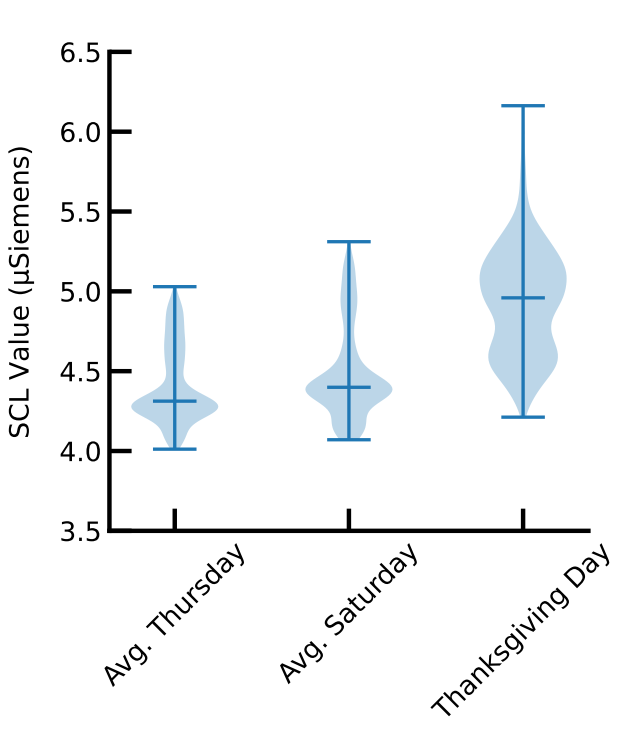
Mean SCL on Thanksgiving Day was higher than both the typical Thursday or Saturday in November and December.
Major sporting events are opportunities for in-situ stress measurement. The 57th (LVII) Super Bowl featured the Kansas City Chiefs and the Philadelphia Eagles on February 12th 2023. This exciting back-and-forth game provided another opportunity to observe how a sports team winning or losing can impact our arousal levels — all within the timespan of the same game! In this match-up the teams were tied towards the end of fourth quarter before a game winning field goal in the final seconds that led to victory for Kansas City and the moment of highest sympathetic activation in our cohort. The average SCL for users whose home states was Kansas showed high variations and particularly prominent peaks during that final field goal, the final whistle and during the trophy award. In contrast, data from viewers who consented to this research in Pennsylvania indicated a different, less excited, physiological EDA profile towards the end of the game.
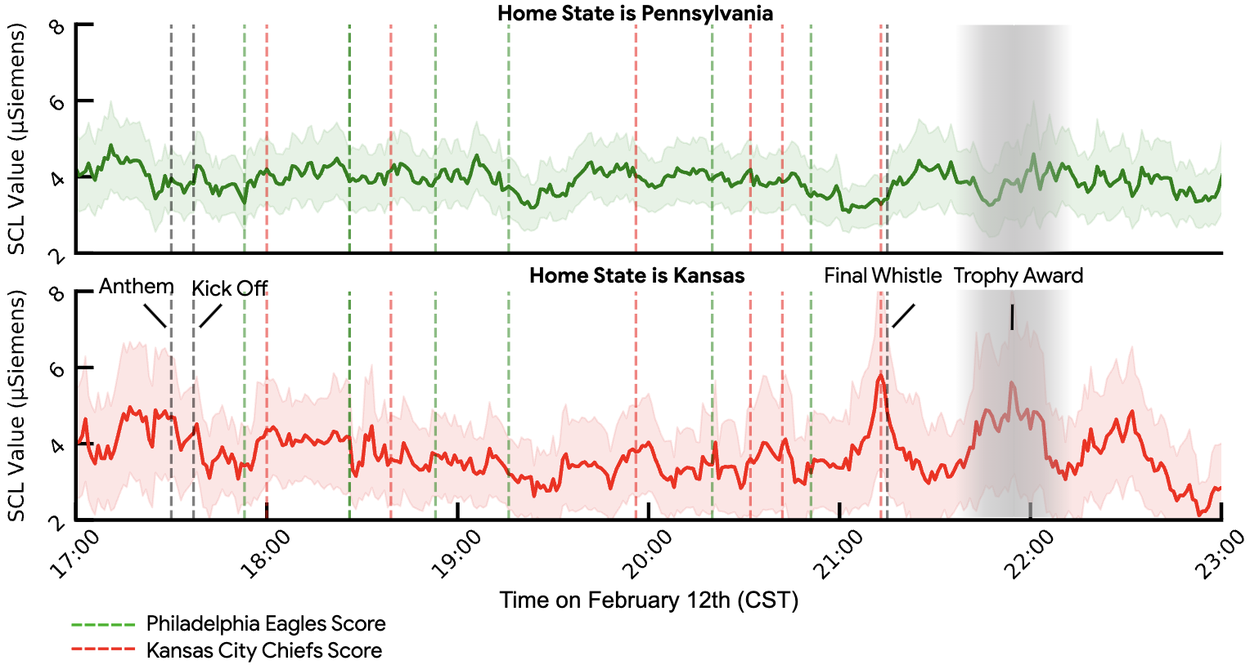
Mean SCL value for subjects whose home state was Pennsylvania (state of defeated team, the Philadelphia Eagles) and Kansas (state of the victorious team, the Kansas City Chiefs). SCL for those from Kansas was significantly higher during the final field goal, end of the game and trophy award than for those from Pennsylvania. Note: Kansas City is split between the states of Kansas and Missouri, but in this analysis we use Kansas.
More mundane examples show that the wrist-worn EDA sensor captures higher arousal during meetings at work and when putting two toddlers to bed at the end of the day (shown below).
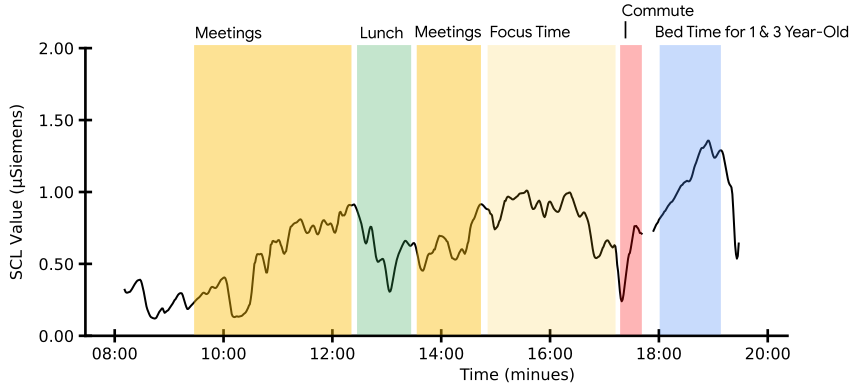
The author’s skin conductance level for a Wednesday in May 2024.
Circadian patterns in EDA
We also retrospectively analyzed anonymized data consisting of 10 million hours of continuous EDA data from almost 16,000 people, to date the largest EDA dataset developed. Diurnal and circadian patterns play an important role in helping to understand patterns of daily human behavior, and we wanted to understand if EDA can be used to observe these patterns.
For SCL we observed a nadir near 10pm and a zenith near 6am (both local time). This means that sympathetic activity was greatest in the early morning and lowest in the late evening. This result is consistent with previous research based on blood pressure measurements. We also observed a secondary minimum at 10am and a second spike at 6pm, meaning that the pattern is double peaked, unlike other physiological signals that typically have a single cycle. Interestingly, these spike-nadir patterns deviated significantly between weekdays (shown below in blue) and weekends (below in yellow), a difference that applied to several other physiological signals. These variations are not just explained by greater physical activity (e.g., more walking) but are driven by other psychosocial factors likely associated with work and non-work days. It is possible that greater levels of social interaction on weekends drives higher sympathetic activity.
Diurnal Variations in SCL show a dual-peaked pattern: SCL measurements were typically elevated in the early morning and in the late afternoon. EDA is measured in microsiemens, the higher the value the more easily electricity flows through skin, meaning more sweat is present.
Applications in mental health research
In our second paper, “Evidence of Differences in Diurnal Electrodermal, Temperature, and Heart Rate Patterns by Mental Health Status in Free-Living Data”, we analyze data for a more specific context, mental health and wellbeing. EDA is a measure of sympathetic arousal that has been linked to depression in laboratory experiments. However, outside of controlled settings, the inability to measure EDA passively over time and in the real world has limited insights about EDA as an indicator of mental health status. The availability of an EDA sensor on a consumer device enabled us to conduct research (with informed consent) into mental-health applications of the device.
We used data collected with informed consent as part of a prospective, nonrandomized study to investigate patterns and relationships between digital device use patterns. This data included sensor data from phones and wearables reflecting both behavioral and physiological processes, and self-reported measures of mental health and well-being. The study protocol was four weeks long with passive sensing from a wearable (Fitbit Sense 2) for the complete four-week period. We examined the association between passively collected, diurnal variations in EDA and symptoms of depression, anxiety and perceived stress in this sample.
We found that subjects who exhibited elevated depressive and anxiety symptoms had higher SCL, skin temperature, and heart rate, despite not engaging in greater physical activity, compared to those that were not depressed or anxious. These differences were statistically significant and consistent throughout most of the day for SCL and heart rate. The elevation was most prominent in the early morning/night time hours. In contrast, subjects who only exhibited elevated stress, based on the Perceived Stress Scale (PSS), only exhibited higher skin temperature. Most strikingly, differences in EDA between those with high versus low symptoms were most prominent during the early morning, suggesting there could be a connection to early morning awakenings and sleep disorders that are linked to depressive orders. We did not observe amplitude or phase differences in the diurnal patterns. Our work suggests that electrodermal sensors may be practical and useful in measuring the physiological correlates of mental health symptoms in-situ and that recent consumer smartwatches might be a useful tool for doing so.
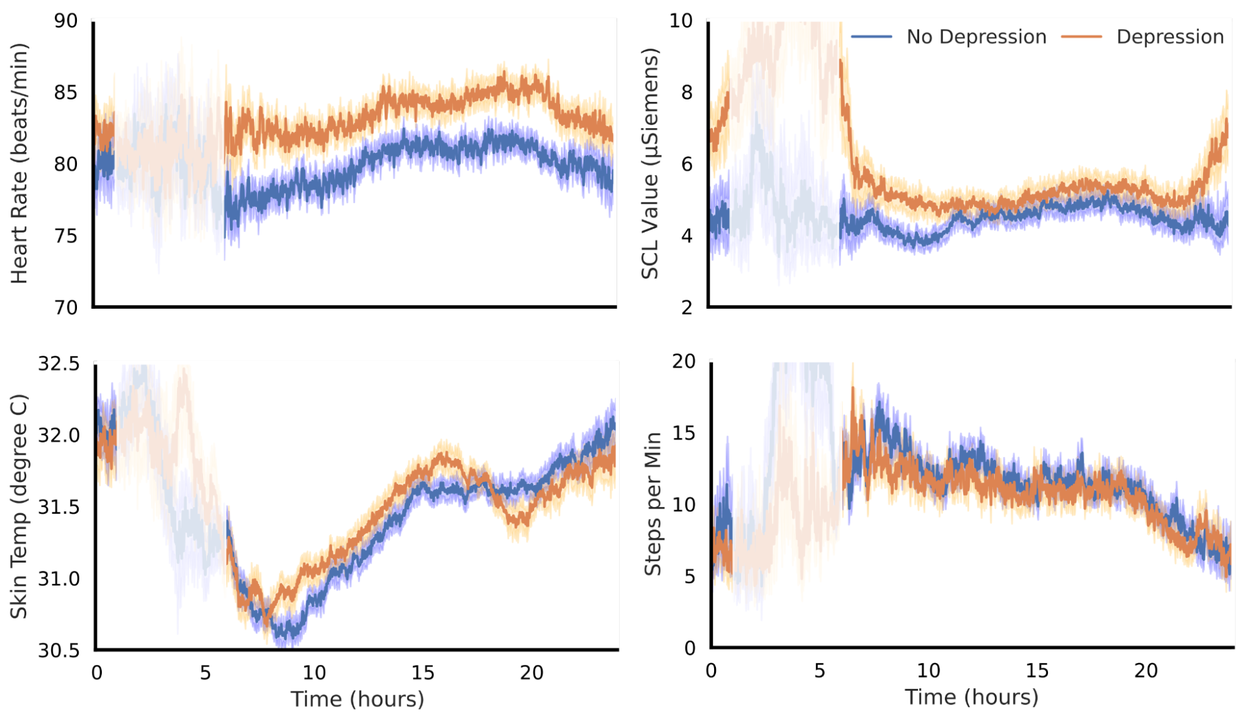
Elevated heart rate and skin conductance level were observed in the depressed population throughout the day. The shaded areas represent 95% confidence intervals. The opaque region between 1-6am represents the low confidence in this region due to a smaller sample size.
Conclusions
The ability to regularly measure EDA on the wrist opens up exciting new avenues for research and personal understanding and could pave the way for personalized mental health support and improved well-being for individuals worldwide. By leveraging wearable technology and large-scale data analysis, we can uncover patterns in our physiological responses to stress, excitement, and even our daily routines. This knowledge can empower us to make more informed decisions about managing our well-being by recognizing the subtle ways our bodies react to the world around us.
Acknowledgements
Samy Abdel-Ghaffar, Conor Heneghan, Lindsey Sunden, Jake Sunshine, Xin Liu, Florence Thng, Andrew Barakat, John Hernandez, Nicholas B. Allen, Ari Winbush, Ming-Zher Poh Allen Jiang, Xin Liu, and Benjamin W. Nelson.
-
Labels:
- Health & Bioscience


